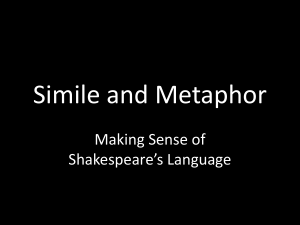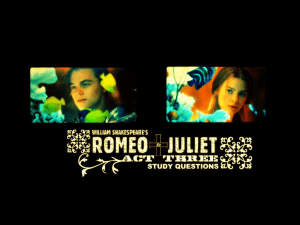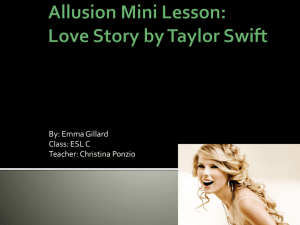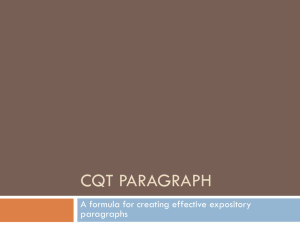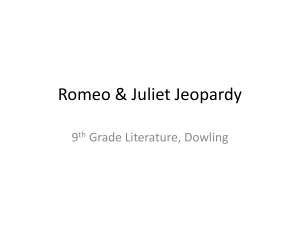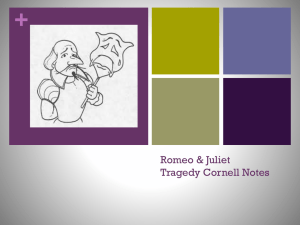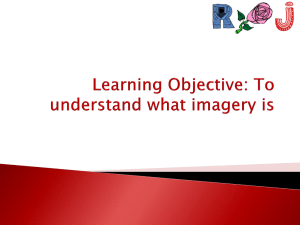Theme: The true nature and dangers of love
advertisement
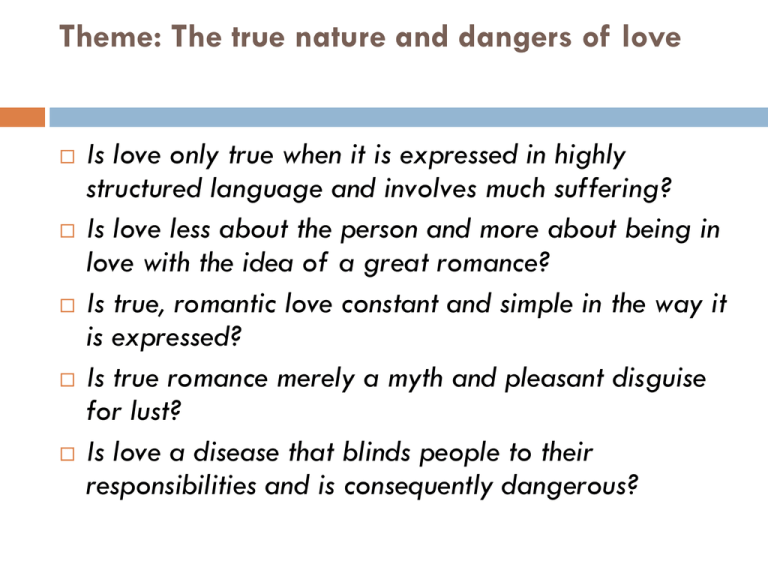
Theme: The true nature and dangers of love Is love only true when it is expressed in highly structured language and involves much suffering? Is love less about the person and more about being in love with the idea of a great romance? Is true, romantic love constant and simple in the way it is expressed? Is true romance merely a myth and pleasant disguise for lust? Is love a disease that blinds people to their responsibilities and is consequently dangerous? The True Nature and Dangers of Love In the play Romeo and Juliet the true nature and dangers of love are discussed by many characters. However, no matter what opinion the characters have, they all seem to agree on one thing: it is an extreme emotion that possesses the power to shape a person’s actions and destiny because lovers are by nature obsessive. The desirable yet potentially destructive nature of love leads to extremely divided opinions about how a love affair should be conducted. In fact, many characters are confused by their own mixed emotions: one minute love seems the ultimate attainment of perfection and the next it is an illness that blind them to their responsibilities. Shakespeare examines these conflicting opinions through contrasting characters who speak using differing levels of formality when discussing love. What do the characters in Romeo and Juliet believe love is? Here are some ideas put forwards by a variety of characters in play. Discuss and decide which character or characters are shown to believe this. Try to pinpoint a specific moment where they say something that directly or indirectly shows they hold this opinion: Love is most passionately expressed through the ‘rules’ of courtly love Love requires suffering, both mental and physical True love is mutual True love is expressed through actions rather than words Love is confusing because it always involves conflicting emotions Fulfilling societal and familial duties is far more important that the pursuit of romantic love Lovers are generally more in love with the idea of being in love than the actual person Love is dangerous when acted upon suddenly without forethought Love is a pleasant disguise for lust and is merely driven by physical desire What is Courtly Love? The phrase “courtly love” refers to a set of ideas about love that were enormously influential on the literature and culture of the Middle Ages. Beginning with the Troubadour poets of southern France in the eleventh century, poets throughout Europe promoted the notions that true love: only exists outside of marriage may be idealized and spiritual may exist without ever being physically consummated; requires a man to become the servant of the lady he loves. One of the main motifs in literature from this time period is that love is a torment or a disease. When a man is in love he cannot sleep or eat; therefore, he undergoes physical changes, sometimes to the point of becoming unrecognizable. Although very few people’s lives resembled this ideal, the concept was extremely popular and widespread in literature and culture, particularly amongst products associated with the royal and noble courts. The Stages of Courtly Love 1. Attraction to the lady, usually via eyes/glance 2. Worship of the lady from afar 3. Declaration of passionate devotion 4. Virtuous rejection by the lady 5. Renewed wooing with oaths of virtue and eternal fealty 6. Moans of approaching death from unsatisfied desire (and other physical manifestations of lovesickness) 7. Heroic deeds of valor which win the lady's heart 8. Consummation of the secret love 9. Endless adventures and subterfuges avoiding detection BENVOLIO Why, Romeo, art thou mad? ROMEO Not mad, but bound more than a mad-man is; Shut up in prison, kept without my food, Whipp'd and tormented and--God-den, good fellow. (1.2.3) What stage of courtly love is Romeo adhering to in this quote? How is courtly love explored in Romeo and Juliet? Shakespeare knew about the code of courtly love and mocks it in Romeo and Juliet. In Elizabethan times, the concept had changed somewhat and didn’t just apply to affairs. However, the notions of suffering through devotion and using flowery language to express desire were certainly still around. Many people now thought courtly love was a little outdated or too ‘French’ to be considered serious. Romeo is first consumed with an infatuation for Rosaline and this love is expressed in the language typical of courtly love. Soon, however, this is replaced by true love when he meets Juliet. Shakespeare seems to define true lovers as being mutually in love. Romeo and Juliet’s love is shown to be genuine when it is contrasted with other characters: Juliet’s parents see love as a practical business arrangement that can increase social and financial status when planned well. Love is not a meeting of minds: it is a meeting of “two households, both alike in dignity”. The constant crude sexual innuendos flowing from Mercutio, the Nurse and some servants suggest that romantic love is just a polite disguise for lustful intent. Romeo’s first ‘love’ seems to follow the rules of courtly love and therefore lacks any true connection between the pairing. He seems more in love with the idea of being in love than actually acting upon any genuine emotion. Courtly love seems to be exaggerated, often one-sided and therefore false. How do we know Shakespeare is mocking this type of love? Romeo is initially a parody of a love-sick courtier with undeveloped poetic abilities. As his love for Juliet grows, so too does his poetic skill. In fact, Friar Lawrence teases Romeo about his expressions of love: “Thy love did read by rote, that could not spell” (2.4.88). Basically he is telling Romeo that his poetry is predictable, clichéd and possibly written by someone else. Romeo’s exaggerated lines regarding Rosaline at the beginning of the play suggest that he is not to be taken seriously. He has an understanding of the conventions of courtly love, but is too young and inexperienced to demonstrate sincere feeling in his verses. Look at these examples: “Feather of lead, bright smoke, cold fire, sick health” (1.1.183), is similar to a line from Philip Sidney’s Astrophil and Stella: “Of living death, dear wounds, fair storms and freezing fires” (6.4. 461). Romeo is just taking lines and copy patterns from other poems but even then doesn’t do a very good job. When Romeo laments the distressing effects of being in love he overly self-absorbed and doesn’t consider Rosaline’s point of view very much. Romeo cannot create a full sonnet for Rosaline. Expect for the sestet in the “devout religion of mine eyes” lyric (1.2.91-96) Romeo can only manage heroic couplets. Elizabethan audiences, well versed in the language of courtly love, would have recognized Romeo’s borrowed patterns and mistake sregarding structure. In early scenes of the play, he would have been seen as a comical or adorable character; a boy that is far too young for the evils of love. How does Romeo’s language change after he meets Juliet? After this initial meeting with Juliet, the imagery in Romeo’s poetry also begins to change and mature: But soft! What light from yonder window breaks? It is the East, and Juliet is the sun! Arise fair sun, and kill the envious moon, Who is already sick and pale with grief That thou her maid art far more fair than she (2.2.2-6). The comparison of Juliet to the sun is far from original and continues to use the conventions of courtly love, yet his tone has changed; Juliet is now the focus of his lines and for the first time, there is genuine feeling. Technically, Romeo’s poetry has also evolved from short couplets to advanced blank verse containing enjambments and mid-line breaks with fewer end-stopped lines: The brightness of her cheek would shame those stars As daylight doth a lamp; her eyes in heaven Would through the airy region steam so bright That birds would sing and think it were not night (2.2.19-22). Why is it necessary to appreciate this development in language? In order for the tragedy of the play to take shape, audiences must believe that Juliet is Romeo’s first and only true love. It is necessary, therefore, in the opening scenes, to portray Romeo as an inexperienced parody of a love-sick courtier with undeveloped poetic abilities. Dramatically, Romeo grows from a young, self-indulgent victim of love, to the passionate, poetic adult in love. This is achieved through the evolution of Romeo’s skill and versatility with language. Now look at the development of Juliet’s language before and after her wedding. Can you see a maturity developing? Why is it necessary to appreciate this development in language? In order for the tragedy of the play to take shape, audiences must believe that Juliet is Romeo’s first and only true love. It is necessary, therefore, in the opening scenes, to portray Romeo as an inexperienced parody of a love-sick courtier with undeveloped poetic abilities. Dramatically, Romeo grows from a young, self-indulgent victim of love, to the passionate, poetic adult in love. This is achieved through the evolution of Romeo’s skill and versatility with language. Now look at the development of Juliet’s language before and after her wedding. Can you see a maturity developing? Conventions of language associated with courtly love Sonnets are A soliloquy is a speech in which a character reveals his or her thoughts to the audience, but not to the other characters; it is usually longer than an aside and not directed at the audience. Shakespeare uses soliloquies to reveal the conflicts various characters struggle with, such as Romeo’s lovelorn state, or Juliet’s conflict over whether or not to “kill” herself. These soliloquies also show how character develops over the course of the play. For example, Romeo’s soliloquy before killing himself in the Capulet tomb shows how love has changed for him and become more real.
